There are a lot of books out there written for guitarists. Most books focus on the ‘how to’ of learning guitar and explain basic techniques, music theory, or how to play songs.
But there is a lot more we can learn as guitarists from books. If you only read instructional how-to books, you’ll miss out on a lot of great wisdom and advice. The books covered in this guide are so good they are considered by many as must-have books for guitarists.
Some of these books teach you techniques and theory, while others take a very different approach. If you’re looking at growing as a guitarist and as a musician, I highly recommend you work your way through this list of books.
Creative Guitar 1 and 2 by Guthrie Govan
Guthrie Govan is a phenomenal guitarist from a technical point of view as well as a creativity point of view. If you’ve seen videos of him playing guitar, you’ll know how passionate he is about his playing.
While you can find interviews and videos on YouTube of Guthrie explaining his approach to guitar, the books Creative Guitar 1 & 2 give a comprehensive and detailed look at techniques, theory, and general advice from Guthrie.
Note: while there is a ‘Creative Guitar 3’ book, it was not by Guthrie and has nothing to do with these two books.
Creative Guitar 1 – Cutting-Edge Techniques Review
The first half of Creative Guitar 1 has Guthrie giving a brief overview of different topics such as tone, technique, tuning, finger pain, etc. He is thorough in covering all topics a guitarist should know about and gives some good insights into each topic.
While the information covered will be great for beginner or intermediate guitarists, experienced guitarists will have heard it all before.
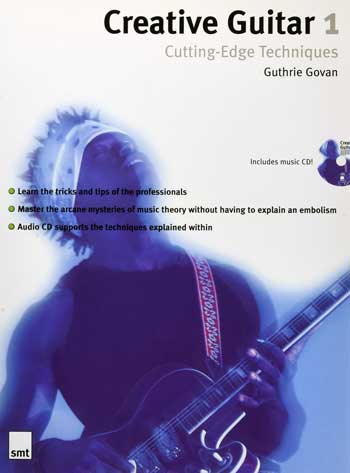
The first 47 pages of the book is one long wall of text. You don’t see any pictures, diagrams, or anything else until page 48 where you’re given the first TAB example. I found this a bit disappointing, but another way of looking at it is that the first half of the book covers the basics so you can skip the sections you already know about.
The second half of the book is packed with exercises and examples.
Guthrie explains how to use music theory to build chords and scales, how to use the CAGED system, Pentatonic scales, modes, arpeggios, and other related topics.
This is a great way to learn music theory, but if you already have a good understanding of music theory, you might end up skipping large sections of the book.
Overall, I feel this book is misnamed. This is more a book on music theory than it is on techniques. The fact that the technique section of the book is completely text-only and is less than a third of the book should tell you what it isn’t the main focus.
There isn’t a single photo of a hand playing a bend, palm-muting or performing any other technique. There are many other books that will do a far better job at teaching you technique. This book teaches you music theory and how to apply it.
Summary: Think about this book as a masterclass of fundamentals. If you already know the fundamentals, there isn’t much here for you. But if you’re just getting started with music theory, want to improve your improvising, or feel you have some gaps in your understanding of music, this is a great book.
Recommended for: intermediate guitarists wanting to build their improvising or songwriting skills. The book will teach you all of the topics you need to know to fully understand the music you create.
Not recommended for: advanced guitarists who already have a solid understanding of music theory and how to apply it. If you already know how to build scales or chords from scratch, then you may not learn much in this book on fundamentals. I also don’t recommend the book for beginner to intermediate guitarists wanting to learn techniques such as bends, vibrato, tapping, etc. Despite the name, this book isn’t about technique – it’s about music theory.
Check out Creative Guitar 1 here (link to Amazon).
Creative Guitar 2 – Advanced Techniques Review
As explained above, the first Creative Guitar book had very little to teach about technique. Fortunately, the second book is completely dedicated to technique.
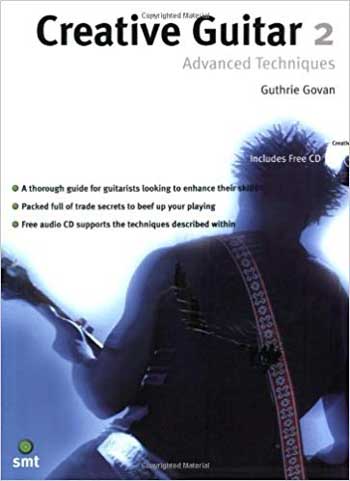
Here is a summary of the techniques and concepts covered in Creative Guitar 2:
- Alternate picking
- Sweep/economy picking
- Legato
- Tapping
- Hybrid picking
- Extending scales
- Emulating other instruments
- Chord ideas
- Using the ‘wrong’ notes
- How to approach new scales
If these topics sound interesting to you, then you will probably enjoy the book.
Other techniques are covered throughout the book, so the above list isn’t comprehensive.
There are plenty of examples and exercises for each idea or technique. I found that I really enjoyed playing the examples as they really did showcase how the techniques could be used in musical ways.
Quite often techniques books give you examples of the techniques that sound bland and uninspiring. Most of these exercises and examples sound like they could easily find their place in a song.
If you’re looking at developing your techniques to a high level, you will get a lot out of this book. Guthrie explains everything clearly and gives you plenty of ideas on how to apply each technique.
Summary: Creative Guitar 2 does a fantastic job of teaching advanced techniques. More important than the actual techniques, Guthrie does a great job at explaining how to use the techniques in musical ways.
Recommended for: advanced guitarists wanting to take their playing to a higher level. The examples are far more interesting to play than any other technical how-to book I’ve read.
Not recommended for: beginners or guitarists who play styles of music where the listed techniques above aren’t used. If you have no interest in the techniques mentioned earlier, you may not get much out of the book.
Check out Creative Guitar 2 here (link to Amazon).
Zen Guitar by Philip Toshio Sudo
Zen Guitar is a book so many guitarists need to read. The title and philosophical focus may put some guitarists off, but it contains powerful lessons and wisdom that can apply to everyone.
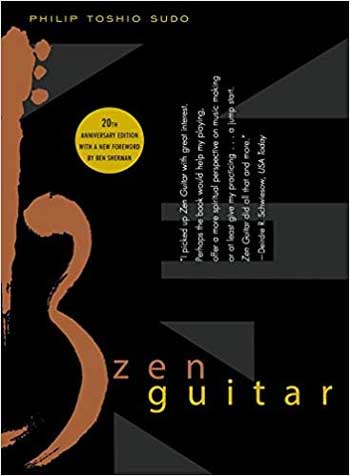
Reading this book is like sitting with a wise and experienced guitar master. Would you expect to learn scale exercises from a wise guitar master? Probably not. It’s far more likely the master will talk about your mindset when you play, the heart and soul you put into your playing, how to deal with ruts and plateaus, or how to find your own signature sound. Learning those lessons will do far more to your playing than learning a few scale exercises.
There are countless books that will teach you the ‘how-to’ of playing guitar. Zen Guitar is more interested in the ‘why’ of playing guitar.
The goal of Zen Guitar is to put you on a path to acquire wisdom as a guitarist. With the path the book sets out for you, you’ll be less likely to fall for common traps that distract or slow down so many other guitarists.
Who is Zen Guitar for?
Zen Guitar was written for guitarists of all skill levels, but I wouldn’t quite recommend it for everybody. I do recommend everybody give it a chance because the lessons are so powerful.
The type of guitarist I highly recommend this book for is anybody who feels lost, stuck in a rut, or frustrated with your rate or progress or ability level. If you’re not completely enjoying every moment of playing up your guitar, read this book.
I also highly recommend this book for any guitarist who wants to be the best guitarist they can possibly be. If you’re passionate about guitar and want to become the best musician possible, you will get a lot out of this book.
Who isn’t Zen Guitar for?
While the wisdom and insights this book provides are applicable to all guitarists, I know not everybody will enjoy reading this book.
Here’s a simple test to see if you’re ready for this book or not. Read the below Zen proverb and think about how it applies to guitar:
A well-known professor went to visit a Zen master. As the master served tea, the professor described his ideas of Zen. The master remained quiet as the professor spoke, continuing to pour.
When the tea reached the brim of the cup, the Zen master kept pouring. The tea overflowed, spilling onto the tray, the table, and the carpet.
“Stop!” the professor said. “Can’t you see the cup is full?”
“Exactly,” said the master. “You are like this cup; you are full of ideas. You come and ask for teaching, but your cup is full; I can’t put anything in. Before I can teach you, you must empty your cup.”
If your eyes glazed over as you read the proverb or you couldn’t care less about how it applies to guitarists, then this book isn’t for you. While I honestly feel the lessons and insights this book provides are important for every guitarist to learn, I know some people won’t be able to get past the focus on philosophy.
If you read the above proverb and are open to thinking about deep topics like this and how it applies to you as a guitarist, then I recommend reading the book.
This is such a powerful book that I have written a thorough review and summary of Zen Guitar here. If you’re interested in this style of teaching, my summary will give a good idea of whether you should read the full book or not.
The Guitar Player Repair Guide By Dan Erlewine
The Guitar Play Repair Guide is a comprehensive instruction book on how to take care of your guitar, make adjustments, or fix problems. It contains essentially every topic you would want to see about maintaining and repairing your guitars.

Think of this book as a manual for your guitar. If you notice some fret buzzing, poor intonation or you have any other problem with your guitar, you can use this book as a quick reference to find the solutions.
The table of contents makes it fairly easy to find the right sections for any problem you’re facing and there are plenty of photos and diagrams to help you understand different parts of your guitar. The layout and index could be better, but it shouldn’t be too hard to find the relevant sections for what you want to do.
The only add part of the book is the section on ‘Pro Setups’. When you hear that title, you might expect to see examples of different setups from guitarists who play different styles of music. It would be really handy to see examples of different setups so you can figure out what is best for you.
Unfortunately, that’s not what is covered. Instead, it focuses solely on a few blues guitarists such as B.B. King, Stevie Ray Vaughan, and Buddy Guy. The section includes long interviews and a close look at their guitar setups. The author clearly loves his blues, but it was a bit jarring to have this section in what is basically a how-to manual.
There’s a six-page interview where B.B. King talks about Lucille (his guitar). It’s interesting if you’re a blues fan, but for everybody else, it’s pointless and irrelevant to have in a guitar repair guide.
Fortunately, the rest of the book contains a good range of information on important topics.
Who is the Guitar Player Repair Guide for?
When deciding if this book is right for you, it’s worth comparing what it has to offer over what you can easily find online. While the book is comprehensive and contains a lot of great information, sometimes you learn more from a video demonstrating how to adjust intonation or make a repair.
If you like the idea of having a guitar manual with you whenever you want to work on your guitar, it makes sense to get this book. On the other hand, if you know how to properly search Google or YouTube, a book like this seems a bit obsolete. It’s easier to watch somebody explain and set intonation on YouTube than it is to read how to do it in this book.
While I won’t pretend that this website comes close to the detail provided in the book, for many guitarists the articles I write contain everything they would want to know about topics such as guitar action height, how to change pickups or many more.
I recommend this book for anybody who really wants to know their gear and do everything themselves. If you’re interested in learning how to repair your guitar, modify it, or learn about general maintenance, it’s a great resource.
Who isn’t the Guitar Player Repair Guide for?
If you’re a beginner, it’s probably too soon to get this book. The book can get pretty technical and it’s not a good idea for a beginner to break out the fret file to try and work on your frets. While a beginner may find this book helpful for basic jobs such as replacing strings, most of what the book covers will be way too advanced.
If you’re a beginner or intermediate guitarist, you can find all the information you want to keep your guitar in good working condition with a quick Google or YouTube search. I write a lot of articles on this site to explain the parts of the guitar and how to use them. Sometimes watching a video on YouTube will cover everything you need to know about a topic.
Check out the Guitar Player Repair Guide here.
Atomic Habits by James Clear
While you can learn a lot from books written specifically on guitar topics, there’s another type of book that can have a massive impact on your abilities as a guitarist. Psychology books and books that look at how we develop skills and learn new things can make a big difference to your progress.
Atomic Habits looks at how we form habits, how to set positive habits, how to change bad habits, and more.
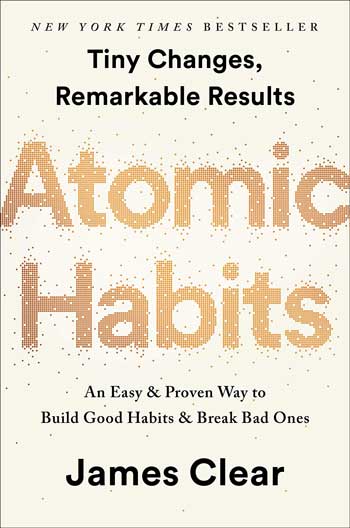
As a guitarist, your progress depends heavily on your practice habits. Practicing is a habit and guitarists who are able to achieve high levels of ability or musicality all have a solid practice habit.
Develop a solid practice habit is a crucial part of learning guitar, yet barely any guitar books do a good job of pointing this out and properly explaining how to build a solid practice habit. Even guitar teachers often struggle to help students develop a solid practice habit because they often don’t understand how habits form. This book does a great job of explaining the science behind habits and how they form.
With the lessons from this book, you can develop a solid practice routine that you will stick to. You’ll also be able to fix bad habits in your guitar techniques and replace them with good habits.
If you ever feel like you’re not practicing enough, can’t stay motivated during practice, or you put off practicing, I highly recommend this book. Once you learn how habits form and how to develop a good practicing habit, you can also apply the same knowledge to other areas of your life outside of guitar.
There are countless books that look at habit building, but this is one I felt was the easiest to read with a practical focus.
Mindset: The New Psychology of Success by Carol Dweck
Mindset by Carol Dweck is another psychology book with a powerful lesson. The findings from this book completely changed my attitude as a guitar teacher, as a guitar player, and in other areas of my life.
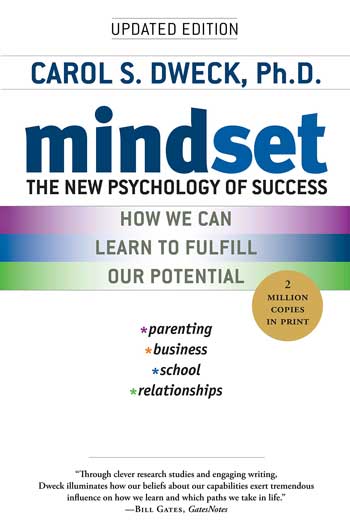
Most guitarists know that the mindset you have plays a big part in how well you progress as a guitarist. But this book looks at research into mindsets and explains the big difference between two key mindsets you may take.
The key lesson from this book is that people can have one of two mindsets: a Growth Mindset or a Fixed Mindset.
Which mindset you have not only sets the way you think about yourself and your guitar abilities, but it has a huge impact on your future abilities as a guitarist (as well as other areas of your life).
A fixed mindset is when you believe that your intelligence, abilities or personality are part of who you are and can’t be changed. When somebody says they can’t learn guitar because they’re “tone-deaf” or they don’t have musical talent, they have a fixed mindset. If a guitarist has a fixed mindset and struggles to play a barre chord, they may quit the guitar and feel they don’t have the talent for it.
Guitarists of all skill levels can have a fixed mindset, so don’t think this is only for beginners. An advanced guitarist with a fixed mindset may struggle to try new things, listen to different styles of music or may give up when they feel they’ve hit the “limit” of their abilities.
A person with a growth mindset believes that intelligence, abilities or personality can all be improved with effort. A guitarist with a growth mindset won’t feel like a failure if they can’t play a barre chord or play in time to a metronome. Instead, that guitarist will think about what needs to be done to improve their skills. They know that they can improve if they put enough practice in. In other words, their growth mindset lets them know that they can improve.
The key idea is that a person with a growth mindset is willing to push past challenges and failures because they know they can change. A person with a fixed mindset doesn’t want to try to push past failure because they don’t believe they can make a difference.
As a guitar teacher, I see evidence of fixed vs growth mindsets in every student I teach. How a student thinks and talks about himself can tell me straight away whether I’m going to have a tough time as a teacher because of their fixed mindset, or a relatively easy time thanks to their growth mindset.
Most of my job as a guitar teacher, in the beginning, is to help a student develop a growth mindset. Once a student has a growth mindset, the progress they can make can be astounding.
Who is Mindset for?
I cannot emphasize how important it is to develop a growth mindset if you want to improve as a guitarist. Once you learn to identify a fixed vs growth mindset in yourself and in other people, you will see it everywhere. You will be able to stop your own fixed mindset from limiting your growth as a guitarist and develop your own growth mindset.
You will also start to see what type of mindset other people have about themselves. It’s almost as if everybody has a big sticker on their head saying “fixed” or “growth” and that sticker controls their actions – yet they don’t know the sticker exists!
The lesson from this book is something every guitarist needs to learn – especially beginners just getting started.
While I feel that every guitarist needs to understand the difference between a fixed and growth mindset and how to develop a growth mindset, not everybody will enjoy the book.
The book drags on and on like many psychology books and repeats itself over and over. Instead of reading the book, I recommend searching for “Mindset book summary” on YouTube. Watch a few summary videos from a few different people and you’ll understand the main lessons from the book.
While the book itself may not be considered ‘must-have’ for guitarists, the lessons it contains are crucial for every guitarist to understand.
Check out Mindset by Carol Dweck here.
Guitar Aerobics by Troy Nelson
I reviewed this book back in 2014 and recommended it due to the simple and practical idea behind it.
The basic idea is that it provides you with 365 exercises to work on every day of the year. The exercises gradually increase in complexity, but the core ideas stay consistent through the book.

I like this book because it gives you a simple structure to follow for an entire year to gradually build up your skills. It doesn’t make ridiculous claims like “master the guitar in 30 days!”. Instead, it gives you a clear path to developing some core skills.
Check out my full review of Guitar Aerobics to learn more about the type of exercises contained in the book and how to get the most out of it.
Have a book that should be on this list? There are countless guitar books and if you’ve read one that you feel is must-have for guitarists, let me know here. I’m always keen to read books on guitar so I’d love to hear your recommendations.
